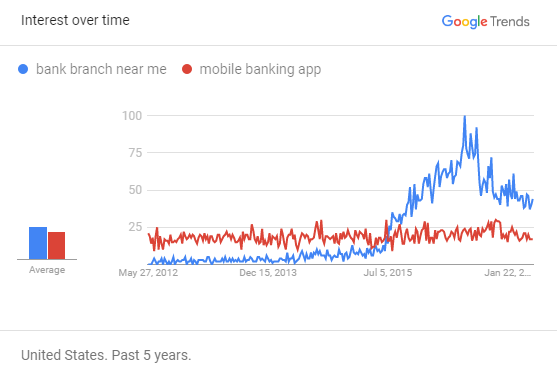 By Brad Powell
By Brad PowellIn the banking and financial service space, biometric authentication is quickly becoming the principal form of mobile authentication. Instead of requiring a password, more and more apps use physical or behavioral characteristics to allow customers to access and manage their money.
Your first response might be: “I already knew that. The big banks have been doing this for a few years now!” Indeed. Biometrics have been around for more than a year at some larger providers, but the rate of change is fairly rapid.
Before we address what’s next, let’s quickly summarize where biometric authentication has been.
Out of curiosity, I compared two search terms on Google Trends recently: “mobile banking app” and “bank branch near me.”
It’s been widely reported that banking on mobile is overtaking branch visits in popularity. So trends in search should reflect that, right? Here’s what Google Trends showed for the past five years:


By Brad Powell
When Facebook announced it was opening its Messenger platform for third-party chatbots in April, a flood of technology and business coverage followed, hypothesizing about what the move could mean for a variety of industries.
Banking was not immune – a Google News search on "banking and bots" continues to turn up a long list of recent articles and blog posts about artificial intelligence-powered chatbots and their potential uses for banks, credit unions and other branches of the financial industry.
Often opening with the detail that Bank of America is planning to develop a bot to interact with customers in Facebook’s mobile messaging app, many of these articles sound similar notes. But a few outlets made points that were more original and intriguing. I wanted to highlight those in this post and add a couple ideas of my own regarding banking and bots.
But first, it’s worth going over the points that most of these articles have in common – the material that makes up the conventional wisdom on the topic.


